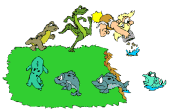Evolution is the process by which life has developed on Earth; the species that exist today are the product of evolution. It is a process that continues today. Over the course of the Earth’s history, millions of different species have evolved, flourished, and then become extinct. Human beings are just once species that has evolved during Earth history, representing a snapshot of evolutionary time.
Evidence that species have changed over the course of the Earth’s history is provided by the fossil record, by patterns of physiological and biological similarity in organisms, and by laboratory experiments demonstrating the ability of living things to gradually change through genetic mutation over the course of generations.
Natural selection is the basic mechanism of evolution. All living organisms are adapted to a specific set of environmental conditions within specific ecosystems. Within every species, however, genetic variation leads to a degree of variation in physical characteristics between different individuals. Some variations allow those who possess them to function more effectively in their particular environment, giving them a greater chance of living long enough and being healthy enough to produce offspring, to which their genes are passed on. This is natural selection; genetic variations that improve the adaptation of an organism to its environment have a better chance of being passed on than variations that hinder adaptation, simply because better adapted organisms are more likely to survive and reproduce.
Human beings in Africa are tall and thin. They have gradually evolved this way because such a physiological shape is most beneficial to heat loss in hot climates. As modern humans gradually migrated northwards, certain bodily characteristics have changed, through natural selection, to be most suited to the cooler climates. Eskimos in Greenland and Northern Canada, for example, are short and plump, and are well suited to the cold conditions there, being more able to retain bodily heat for warmth.
A new species is born when a population of a species evolves sufficiently that interbreeding with other populations of what used to be the same species becomes first unusual then impossible. This is called speciation. One way this often happens is through geographic isolation. When a population becomes physically isolated from other populations of the same species, adaptive variation particular to it and its environment may in time lead to the development of two different species. Hominids migrated out of Africa in two waves, the first as much as 2 million years ago and the second and more recent wave perhaps only 150,000 years ago. During the course of the second migration, the modern human (Homo sapiens or ‘wise man’) came into contact with the Neanderthals, a completely different species of human living in Europe from between 130,000 and 30,000 years before the present, most likely an evolutionary offshoot from the first hominid migration. Despite the Neanderthals’ remarkable intelligence, Homo sapiens seemed more readily able to adapt to the glacial conditions that prevailed in Europe during last Ice Age. Today, Homo sapiens is the only species of hominid left on Earth. The Neanderthals became extinct.
Extinction is the opposite of speciation; it is the process by which species die out. It is a natural process, which has occurred throughout the history of the Earth at almost the same rate as species have originated. In this sense evolution is dynamic. The incredible variety of species that inhabit the Earth today represents a tiny fraction of the species that have ever existed. There have, however, been a number of mass extinctions in the Earth’s history. These were relatively short periods of time wherein a great number of species died. The most serious of these, 250 million years ago, killed off more than three-quarters of the species in the oceans and had a significant effect on terrestrial life as well. The most recent mass extinction occurred 65 million years ago, killing off the last of the dinosaurs. Our own species was born during the period of the greatest diversity of species in the Earth’s history. Unfortunately, we may be beginning to threaten this very diversity of life because of our over consumption, waste production and pollution, and consequential changes that are occurring at an unprecedented rate within the biosphere.
- Working from Home - March 21, 2024
- Eco-Friendly Companies in the UK - March 6, 2024
- Public Transport - February 15, 2020
